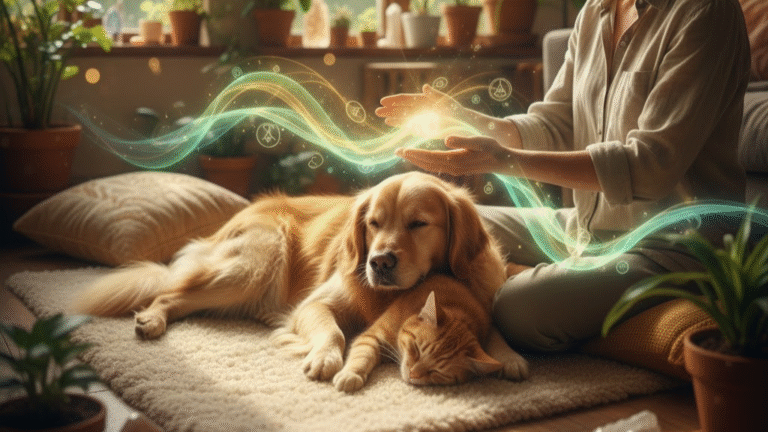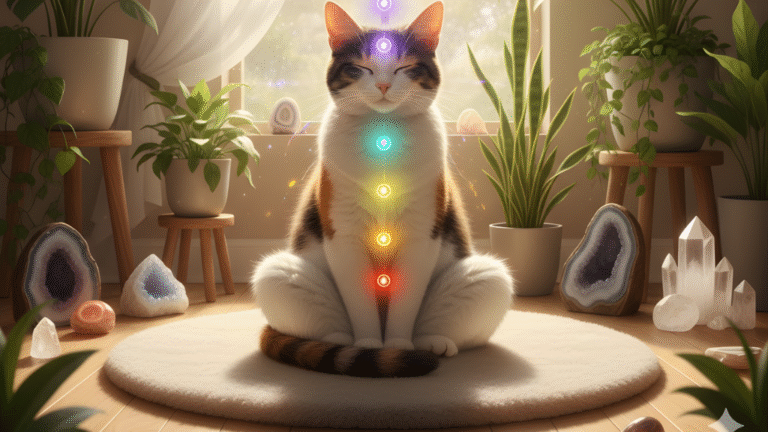Signs Your Pet May Benefit From Reiki Healing
If you’re like me and adore your pets, you probably keep a close eye on their physical and emotional well-being.
Our furry, feathered, and even scaly companions go through tough times just like we do. Sometimes it’s easy to tell when something isn’t right, but other times the signs are subtle.
Over the past years, I’ve been seeing more pet owners turn to holistic approaches like Reiki to support their animals’ overall wellness.
Knowing when your pet could benefit from Reiki healing makes a difference, especially when you want to offer comfort that goes beyond the basics.
Did you know that many pet parents combine their love for animals and Reiki into thriving blogs and businesses? 🐾 Discover how inside Wealthy Affiliate.
Understanding Animal Reiki Healing
Animal Reiki is a gentle, non-invasive energy practice that aims to help pets feel calmer and more balanced, both physically and emotionally.
Practitioners use their hands near or lightly on the animal, allowing a sense of relaxation and peace to flow naturally. There’s no pressure for the pet to sit still, and sessions adapt to each animal’s comfort.
This approach comes from the traditional Japanese technique, but it’s tailored specifically for animals’ unique sensitivities.
Scientific studies on Reiki’s impact in animals are still limited, but many pet parents notice positive changes after sessions.
Whether you have a dog that’s scared of thunderstorms or a senior cat with achy joints, Reiki offers a tool that supports modern veterinary care, rather than replacing it.
Common Signs Your Pet Might Benefit from Reiki Healing
Some signs appear suddenly, while others show up little by little. Here’s what I’ve found to be pretty common signals your animal could do well with a little Reiki support:
1. Changes in Behaviour
Sudden withdrawal, aggression, clinginess, or personality shifts often point to discomfort, pain, or stress the animal may be having trouble expressing in other ways.
2. Anxiety and Nervousness
Frequent pacing, hiding, unusual vocalizations, panting, or tremors can all suggest your pet feels anxious or unsettled.
3. Physical Discomfort
Limping, difficulty getting up, or flinching when touched. Animals are pretty good at masking pain, so these clues often mean they’re struggling more than they let on.
4. Sluggishness
Unusual tiredness, loss of excitement about walks, play, or even food could suggest something deeper is happening.
5. Digestive Upset
Recurring tummy issues, vomiting, or changes in appetite might tie in with emotional tension or physical stress.
6. Trauma Recovery
Adopting a rescue animal or helping a pet adjust after illness, surgery, or a major change (like moving home) sometimes brings up lasting emotional struggles. Reiki can help dial down their fear and help them settle.
7. Overgrooming or Licking
Self-soothing actions like excessive licking or chewing often hint at underlying stress, boredom, or anxiety.
If you see these patterns cropping up—even in a mild way—it’s worth exploring gentle methods like Reiki that work with your pet’s own ability to find comfort and calm.
What To Expect From A Reiki Session With Your Pet
Curious about how a session looks? Here’s how I typically describe it when folks ask:
Your pet is never forced to stick around or do anything uncomfortable. Most practitioners meet animals where they’re at, and if your dog wants to nap nearby, that’s totally fine.
Sometimes, pets approach for closer contact during the session, but there’s no pressure for them to interact if they’re shy.
Usually, animals show some signs they’re tuning in: heavier breathing, droopy eyes, or relaxed limbs. Some drift off for a nap!
Sessions typically last between 15 and 45 minutes, based on what your pet seems comfortable handling.
Afterward, you might see shifts right away, like a calmer mood, more restful sleep, or more interest in playing, or changes might appear subtly over days.
Pets usually guide the pace, and a good practitioner respects whatever your animal feels up for that day.
It’s always best to work with someone trained in animal Reiki and who has a clear understanding of animal body language. Some practitioners even work remotely, especially for anxious or easily stressed pets.
Reasons Pet Parents Choose Reiki Healing
1. It’s Non-Invasive
Reiki doesn’t require medication, needles, or forcing your pet to accept anything scary, which helps ease tension and builds trust.
2. Works Alongside Veterinary Care
Many folks, myself included, see Reiki as a complementary option. Always check with your vet to rule out anything serious first, and then consider how Reiki fits into a bigger wellness plan.
3. Calms Both Animals and Humans
When I sit with my cat during a Reiki session, I find myself relaxing too. Pets often pick up on our mood. Sessions tend to help the whole environment feel more chilled out.
4. Helps With Emotional Transitions
Whether you’ve recently moved, adopted a new pet, or experienced a loss, Reiki gives animals time to work through the emotional impact at their own pace.
5. Natural Support For Senior Pets
Getting older isn’t always easy for our companions. Reiki offers gentle, ongoing care to ease their discomfort and help them rest better.
Steps for Introducing Reiki to Your Pet
1. Start Gradually
Let your pet explore the space and practitioner at their own pace. Comfort should always come first.
2. Pick A Calm Setting
Make sure the room feels safe and quiet. Familiar bedding, favorite toys, or soothing music can help set the mood.
3. Work With A Certified Animal Reiki Practitioner
Not every Reiki practitioner has animal specific training. Look for someone with experience (and check for gentle, ethical handling practices).
4. Monitor Afterward
Watch for changes, both big and small, in how your pet moves, eats, interacts, or rests after the session. This feedback is super helpful for future planning.
Extra Considerations Before Trying Reiki
1. Consult Your Veterinarian
If signs of illness or pain come up suddenly or get worse, it’s worth checking in with your vet before trying anything new.
Reiki can offer wonderful support, but medical care is really important for diagnosing and managing health problems.
2. Individual Differences
Each animal reacts differently to energy work. Some warm up after a single session, while others need several tries to get used to the process.
3. Alternatives And Combination Therapies
Reiki can mix nicely with other holistic options like massage, aromatherapy (using pet safe oils), or acupuncture for pets. Some pets respond best to a combination of approaches.
Behavioural Signs That Often Lead Pet Owners to Reiki
I’ve noticed that some animal behaviors prompt people to explore Reiki more than others. These include reactions to separation anxiety; think pets who panic when you leave the house or seem overly attached.
Fear of loud noises, like fireworks or vacuum cleaners, and nervousness during vet visits are also common triggers that make people look for holistic support.
Physical Concerns And Chronic Conditions
Physical challenges, such as arthritis, chronic pain, or slow recovery after an injury, can really affect your pet’s daily mood and outlook.
Reiki helps many animals relax deeply enough for their bodies to rest and recharge. It’s especially helpful when traditional approaches have plateaued, or your pet is too sensitive for more active interventions.
Frequently Asked Questions
Here are some questions I get from pet parents about Reiki and their animals.
Question: How do I know if Reiki isn’t right for my pet?
Answer: If your pet seems agitated or moves away repeatedly, it might just not be the right time or setting. Some animals just need a slower approach, or maybe they’re better served by different relaxing routines.
Question: Can Reiki replace vet visits or medications?
Answer: Reiki is complementary, not a magic fix. Always continue follow ups and any prescribed treatments. Use Reiki as a gentle boost to your pet’s overall well-being.
Question: Is there a specific age that’s best for Reiki?
Answer: There’s really no age limit. I’ve seen everything from kittens to senior dogs respond positively. Practitioners usually tailor sessions to your animal’s life stage and health condition.
Adding Reiki To Your Pet’s Wellness Plan
Supporting your pet’s comfort and happiness often means exploring different wellness tools, and Reiki can definitely be one to add to your toolkit.
Even small, positive changes, like a pet who finally sleeps through the night or a shy animal that comes out to cuddle, can be really rewarding for both of you.
Working with a professional who understands animal Reiki helps you get the right fit for your companion’s needs.
Gentle, intentional care goes a long way in helping our animal friends thrive, and Reiki is another way to support them along their adventure.
When you notice those little signs, it might be the perfect time to offer your pet extra comfort and care.
I trust you enjoyed this article on the Signs Your Pet May Benefit From Reiki Healing. Please stay tuned for more Reiki insights, pet wellness tips, and holistic lifestyle ideas.
Take care!
— JeannetteZ
💬 Your Opinion Is Important To Me
Do you have thoughts, ideas, or questions? I’d love to hear from you. Please leave your comments below or email me directly at Jeannette@pawreiki.com.
🐾 More PawReiki Reads
💜 My #1 Recommendation for Online Success
Reiki has been life-changing for me, and I love sharing it online. If you’ve wondered how Reiki lovers turn their passion into income, this platform is the best place to start.
🌟 See How Reiki Lovers Build Online Income — Try WA FreeDisclosure
This post may contain affiliate links. I earn from qualifying purchases at no extra cost to you. Please read my full disclosure.







